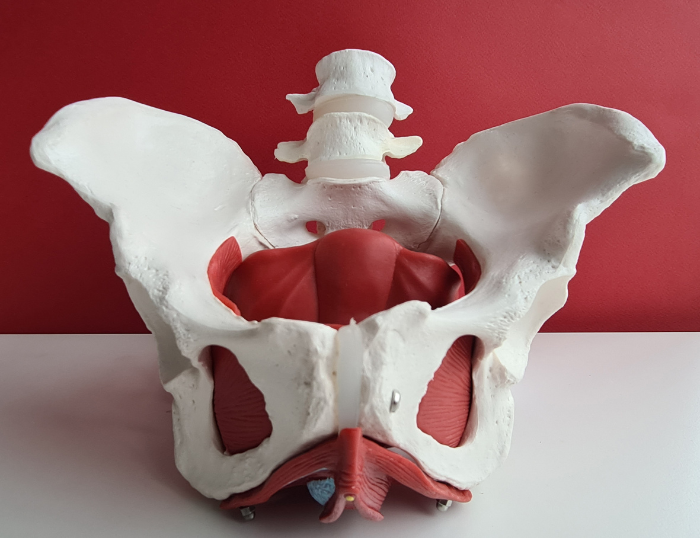

Pelvic Floor PT (PFPT) is a specialized area of physical therapy focused on treating pelvic floor dysfunction. These conditions include urinary and fecal incontinence, pelvic organ prolapse, sexual dysfunction, chronic pelvic pain, and complications following pelvic surgery. Effective treatment relies on thorough assessments, personalized exercise programs, and patient education to achieve lasting results.
The pelvic floor composed skeletal muscle fibers of levator ani combined with coccygeus muscles and fascia and ligaments which create a foundational support for pelvic organs.

They support urinary and bowel continence, helping prevent leakage.
They provide stability to the pelvic girdle and lumbosacral spine, aiding in posture and movement.
They play a key role in sexual function, actively engaging during arousal and orgasm.
They respond to changes in intra-abdominal pressure, helping to maintain core and pelvic stability during everyday activities.
They work in close coordination with the diaphragm and abdominal wall, contributing to overall core control and breathing mechanics.


Physiotherapy assessments need to cover the whole patient function as well as clinical reasoning. Key elements include:
Posture assessment and breathing examination and evaluation of core engagement patterns and lumbopelvic stability form part of the objective measurement process.
The assessment includes external and internal pelvic floor assessment through physical palpation depending on patient consent.
The assessment process may be supported by bladder diaries, frequency-volume charts, and real-time ultrasound imaging.
Pelvic floor muscle training serves as the primary intervention strategy because practitioners need to develop appropriate exercise approaches according to specific neuromuscular conditions of patients.
The training gradually transitions from supine to sitting position then standing and progresses to dynamic movements like squatting as well as walking.
Periods of functional context such as transitions and coughing offer opportunity for practicing motor learning skills.
The first stage of guidance leads patients to learn proper movement mechanics which develops neuromuscular system control and avoids additional strain on the body through gluteal or abdominal muscles (overuse).
Physical therapists use appropriate tactile tools and visual mirrors and EMG compression feedback systems with patients as clinically necessary.
The pelvis must activate when transversus abdominis and diaphragmatic muscles start their work.
The exercise program needs to train people to activate their pelvic floor muscles before their movements start.
Patients need instruction about effective “urge suppression strategies” including deep breathing paired with quick pelvic floor contractions and remaining still to control urinary urgency.
Patients should drink 1.5 to 2 liters of fluid daily and limit their consumption of bladder-irritating substances such as caffeine and alcohol and citrus-juice drinks.
The Knack method of timed pelvic floor contractions during coughing or lifting should be practiced to stop leaking accidents.
The patient needs instruction to maintain proper toileting position and bowel habits which help prevent straining and control constipation.
Patients should learn the “Pelvic Elevator” technique through which they follow visual instructions to lift pelvic floor muscles from baseline to increasing levels of contraction followed by return to baseline for graded strength training.
Patients should use genuine daily cues to enhance their integration (such as lifting before sneezing and activating before impact).
The patient needs instruction about multi-position exercises which combine lying positions with sitting positions followed by standing positions before progressing onto walking ones.
People receive enhanced pelvic floor function after consistent treatment stretches from six to twelve weeks according to clinical evidence. Your pelvic floor health will continue to advance beyond six months to one year after care initiation when you follow a maintenance program.
Outcomes include:
A practitioner delivering Pelvic Floor PT needs to demonstrate profound anatomical expertise together with precision skills along with communication methods customized for each patient. Through correct patient evaluation combined with functional exercise progression physiotherapists help patients achieve pelvic function recovery and enhance their total health. Welcoming PFMT into holistic care approaches enables patients to become more autonomous and develop better quality of life together with enhanced resilience.
The information gained from internal examination helps clinicians recognize tone discrepancies and movement irregularities along with detecting asymmetries. Before internal assessment begins there needs to be patient consent and healthcare professionals need to present alternative procedures if contraindications or rejections occur.
The fundamental concepts hold steady while execution methods differentiate between male and female cases. Men undergoing prostatectomy must receive specific care for urinary control while also regaining muscle function. New mothers and women with prolapse need additional modifications for their exercises.
Pelvic floor PT demonstrates usefulness as a management approach for pelvic organ prolapse.
Yes. The combination of pelvic floor pt with core control and proper load management successfully supports pelvic area structures among patients with prolapse conditions at stages I to III.
Any active medical condition poses an absolute limitation toward starting pelvic floor training including uncontrolled infections, open surgical wounds and active cancers and refusal to participate. Patients needing relative caution should undergo pelvic floor training when they experience complex pain but doctors cannot find a definite diagnosis.
Yes. The strong recommendation exists for both antenatal teaching and pre-operative pelvic therapy since they help prevent dysfunction development and support post-operative outcomes.
Which strategies would effectively motivate patients to sustain their exercises indefinitely? Healthcare providers should establish reminder systems using mobile applications or visual markers as well as present evidence-based symptom control effects to patients while teaching them how these techniques fit into their normal routines such as tooth brushing and standing in lines. The healthcare provider should provide digital support when appropriate in order to reinforce follow-up activities for patients.